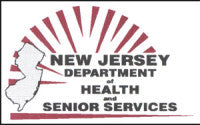Artificial Turf and Human Health Concerns
 April 2008
April 2008
Why is the New Jersey Department of Health and Senior Services studying artificial turf fields?
The New Jersey Department of Health and Senior Services (NJDHSS) and the federal
Agency for Toxic Substances and Disease Registry/National Center for Environmental Health (ATSDR/NCEH) were investigating a contaminated scrap metal facility in the city of Newark, NJ. One of the contaminants at the facility was lead. The facility is next to an athletic field. At the time of the investigation the NJDHSS and ATSDR/NCEH saw children playing on the athletic field. Because lead is hazardous to young children the NJDHSS collected samples from the athletic field to find out if lead from the scrap metal facility was migrating to the field. The samples were tested in a laboratory, which found that there were high levels of lead in the dust.
However, the source of the lead was the artificial turf fibers, not the scrap metal facility.
Because of the finding of lead in this field, the NJDHSS began to test other artificial turf fields to find out if other artificial turf fields might contain high levels of lead.
Did the NJDHSS test other artificial turf fields?
NJDHSS collected artificial turf fiber samples from 12 other fields from around the State. The fiber content of the turf was polyethylene, nylon, or a mix of polyethylene and nylon. The ten fields with polyethylene had very low or undetectable levels of lead in the fibers. The two fields with nylon fibers (as did the field in Newark) had high levels of lead. The lead concentrations were 3,400 and 4,100 milligrams of lead per kilogram of fiber (mg/Kg).
These may be compared with the New Jersey Department of Environmental Protection's standard for residential cleanups, the Residential Direct Contact Soil Cleanup Criteria (RDCSCC) of 400 mg/kg in soil. The RDCSCC value was used in the Newark field because children less than 7 years of age were observed to be playing on the field, and the NJDHSS assumes that children play on the other fields that we sampled, as well.
The New Jersey Department of Health and Senior Services (NJDHSS) and the federal
Agency for Toxic Substances and Disease Registry/National Center for Environmental Health.
Were any other artificial turf products tested?
In addition to municipal and college artificial turf fields, the NJDHSS also collected artificial turf samples from consumer products that are used for residential lawns and play surfaces. Two of the products that were nylon or nylon/polyethylene were tested in the laboratory; both of these samples contained lead at concentrations higher than the RDCSCC (4,700 and 3,500 mg/Kg, respectively).
What is the NJDHSS planning to do next?
We do not know if the lead that is in the artificial turf fibers can enter a child's body as easily as lead in lead-based paint or contaminated soil does. The department is further examining how much lead might be available for absorption into the human body. We expect to have this information by early May 2008.
Because of the potential national implications of this finding, the New Jersey Department of Health and Senior Services has contacted the U.S. Consumer Product Safety Commission to ask for federal intervention.
What does the NJDHSS recommend in the interim?
Agencies that have installed, are installing, or plan to install artificial turf fields should ask
vendors to conduct appropriate testing to determine the levels of potential contaminants in components of the turf, including the turf fibers and in-fill materials.
If a field is found to have high lead levels, field managers can consider limiting access to the field, especially for the most vulnerable population of children under 7 years of age.
As a precaution, until further guidance is available, custodians of all turf fields, but especially turf fields with nylon fibers, can implement the following recommendations, in addition to testing their turf field:
· Dust suppression, in the form of watering down the field, can be conducted before and after the field is being utilized,
· Encourage individuals who use the field to perform aggressive hand/body washing after playing on the field;
· Clothes that were worn on the field should be taken off inside out and washed separately.
Is the NJDHSS also going to study any other aspects of artificial turf fields, including crumb rubber, heat, bacteria, and other concerns that have been raised?
The NJDHSS recognizes the growing public concerns about the safety of artificial turf fields, as well as the need for communities to provide for athletic and other recreational fields. Artificial turf fields are being installed in growing numbers around the country and in New Jersey. Health and safety concerns are being raised about these fields. These concerns are related to physical properties of the fields and potential chemical exposures from in-fill materials (especially crumb rubber from recycled tires) and the turf fibers.
There is a need for a comprehensive and coordinated approach to evaluating the public health risks and benefits of artificial turf fields. Several assessments have been conducted by researchers around the country. Available evidence suggests that there are no acute health risks due to use of artificial turf fields, and risks due to chronic and repeated exposure are unlikely.
However, important gaps and uncertainties in our knowledge of the nature and magnitude of potential exposures and health risks remain.
This information has come from:-
Consumer and Environmental Health Services
Epidemiology, Environmental and Occupational Health
PO Box 369
Trenton, NJ 08625-0369
(609) 584-5367
